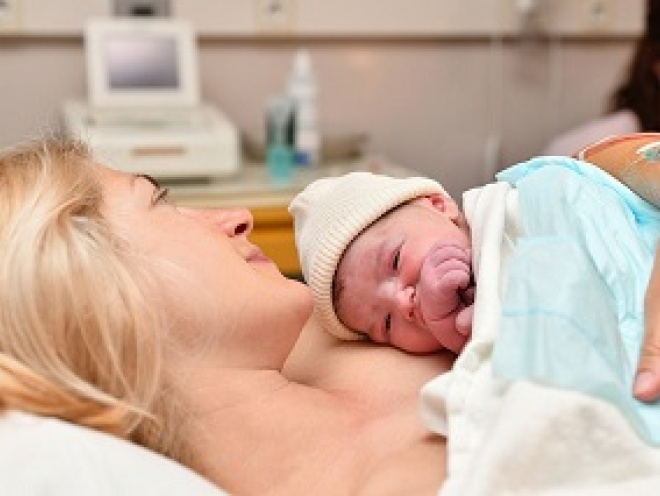If you do have a little bump in the road, here’s what will happen to make sure your baby arrives safely…
Having a baby doesn’t always follow your birth plan. Sometimes you might need help so your child arrives into the world safely and to make sure that you don’t have any problems.
"If you have any complications when you’re giving birth in hospital, you’ll have access to obstetricians, anaesthetists and specialists in newborn baby care. So try not to worry."
Here are some of the things these medical and health professionals will help with.
Delays in labour
You might experience a long labour because:
- your contractions are slow
- your baby’s big or in an awkward position
- your pelvis is too small
- you’re frightened or anxious, which affects your hormones. (Simkin and Anchetta, 2011; Thakar and Sultan, 2014)
When you’re giving birth to your first child, the active first stage averages around eight hours. It’ll never normally be more than 18 hours (NICE, 2014).
The second stage (AKA pushing) is usually no longer than two hours. Subsequent births are likely to be quicker.
If your labour is much slower than that, your midwife might suggest artificially breaking your waters (NICE, 2014). After that, they might try a hormone drip (NICE, 2014).
It’s a personal choice but some women feel like those options can make giving birth more painful and lead to more interventions (NICE, 2008). If that’s how you feel, alternative options are:
- eating or drinking for more energy
- using upright, forward and open positions (active birth can help your labour progress more quickly and reduce pain)
- using a birth ball
- using a birth pool
- dim the lights, use aromatherapy oils or try any other tricks to boost your oxytocin. (Buckley, 2011; Laurence et al, 2013; NICE, 2014; Cluett et al, 2018)
Baby in distress
If they’re in an awkward position or labour is slow, your baby might get distressed. This might cause changes to their heart rate (NICE, 2014). That’s when forceps (large tongs) or a ventouse (suction pump) are used.
Forceps and ventouse are both common practices. But they do have small risks like perineum tears or bruising to your baby (NHS, 2017).
Shoulder dystocia
Shoulder dystocia is when your baby’s head’s been born but one of their shoulders is stuck. If this happens, you’ll need extra help.
Vaginal tears and heavier than normal bleeding are more common after shoulder dystocia. Some babies will stretch the nerves in their neck or (rarely) get more serious injuries. In the majority of cases though the baby will be fine (RCOG, 2013).
Caesarean birth
Sometimes, something happens during labour that means your baby needs to be born by unplanned or emergency caesarean.
A caesarean might be recommended if you’re in labour for a long time without progressing much (NICE, 2014). Other reasons include unexpected problems that might pop up that means your baby needs to be born urgently.
If you’ve had a caesarean before, occasionally the scar on your uterus can separate or tear. If that looks likely, your baby will normally be born by immediate caesarean (RCOG, 2016).
Complications after the birth
Occasionally, complications might occur after your baby arrives. They might include:
- Heavy bleeding (postpartum haemorrhage). If the bleeding carries on, you’ll be given drugs and, if necessary, a blood transfusion.
- Retained placenta. Where all or part of the placenta or membranes stay inside your womb. If the midwife can’t pull the placenta out, it’ll be removed in theatre.
- A tear that your midwife can’t repair. If you have a severe tear, you’ll be given an anaesthetic and taken for surgery (NICE, 2014).
Complicated birth: how do I recover?
Your body can take a while to recover from giving birth, and even longer if you’ve had surgery or stitches. Don’t rush it: that’s totally normal.
If you are worried, discuss any concerns or worries with your GP at your six week check-up. You can also make an appointment sooner if you’re in pain or anxious.
Sometimes complications during labour can leave you feeling:
- traumatised
- disappointed that the birth didn’t go to plan
- powerless or like you weren’t in control. (Shaban et al, 2013)
Most hospitals also offer a birth debriefing service. That’ll allow you to chat through your labour and birth and resolve any unanswered questions.
Other things that can help are:
- learning relaxation techniques
- talking to friends or your partner
- giving yourself time to process it all. (MIND, 2016a)
If those don’t work and you need more intense help, look into:
- trauma-focussed CBT (cognitive behaviour therapy)
- EMDR (eye movement desensitisation and reprocessing). (MIND, 2016a)
You might be suffering from PTSD (post traumatic stress disorder) caused by birth trauma.
If you are finding it difficult to cope or think you might self-harm remember that you can always talk to the Samaritans (MIND, 2016b).
This page was last reviewed in September 2018.
Further information
Our support line offers practical and emotional support with feeding your baby and general enquiries for parents, members and volunteers: 0300 330 0700.
We also offer antenatal courses which are a great way to find out more about birth, labour and life with a new child.
Make friends with other parents-to-be and new parents in your local area for support and friendship by seeing what NCT activities are happening nearby.
The Which? Birth Choice regional guide to labour wards and birth centres provides information about services in your area, including what equipment is already provided.
Samaritans are available round the clock, all day every day, for an immediate response on 116 123.
See Samaritans for further information and other ways to contact them.
Buckley S. (2011) Undisturbed birth. AIMS Journal. 23(4). Available from: https://www.aims.org.uk/journal/item/undisturbed-birth [Accessed 1st September 2018].
Cluett E, Burns E, Cuthbert A. (2018) Immersion in water in labour and birth. Available from: http://www.cochrane.org/CD000111/PREG_immersion-water-labour-and-birth] [Accessed 1st September 2018].
Lawrence A, Lewis L, Hofmeyr GJ et al. (2013) Maternal positions and mobility during first stage labour. Cochrane Database of Systematic Reviews (10): CD003934. [Accessed 1st September 2018].
MIND. (2016a) PTSD and birth trauma. Available from: https://www.mind.org.uk/information-support/types-of-mental-health-problems/postnatal-depression-and-perinatal-mental-health/ptsd-and-birth-trauma/ [Accessed 1st September 2018].
MIND. (2016b) How to improve your mental wellbeing. Available from: https://www.mind.org.uk/information-support/tips-for-everyday-living/wellbeing/#.W9d-sWj7RPY [Accessed 29th October 2018].
NHS. (2017) Forceps or vacuum delivery. Available from: https://www.nhs.uk/conditions/pregnancy-and-baby/ventouse-forceps-delivery/ [Accessed 1st September 2018].
NICE. (2008) Inducing labour. Available from: https://www.nice.org.uk/guidance/cg70/chapter/1-guidance [Accessed 28th October 2018].
NICE. (2014) Intrapartum care for Healthy women and babies. Available from: www.nice.org.uk/guidance/cg190/chapter/Recommendations [Accessed 1st September 2018].
Royal College of Obstetricians and Gynaecologists (RCOG). (2013) Information for you - shoulder dystocia. Available from: https://www.rcog.org.uk/globalassets/documents/patients/patient-information-leaflets/pregnancy/pi-shoulder-dystocia.pdf. [Accessed 29th October 2018].
Royal College of Obstetricians and Gynaecologists (RCOG). (2016) Information for you - birth options after previous caesarean section. Available from: https://www.rcog.org.uk/globalassets/documents/patients/patient-information-leaflets/pregnancy/pi-birth-options-after-previous-caesarean-section.pdf. [Accessed 29th October 2018].
Shaban Z, Dolatian M, Shams J, Alavi-Majd H, Mahmoodi Z, Sajjadi H. (2013) Post-traumatic stress disorder (PTSD) following childbirth: prevalence and contributing factors. Iran Red Crescent Med J. 15 (3):177-182
Simkin P, Ancheta R. 2011. The labor progress handbook: early interventions to prevent and treat dystocia. 3rd ed. Chichester: Wiley Blackwell.
Thakar R, Sultan AH. (2014) The female pelvis and the reproductive organs. In: Marshall JE, Raynor MD. eds. Myles Textbook for Midwives. 16th edn. Edinburgh, Churchill Livingstone: 55-80.








